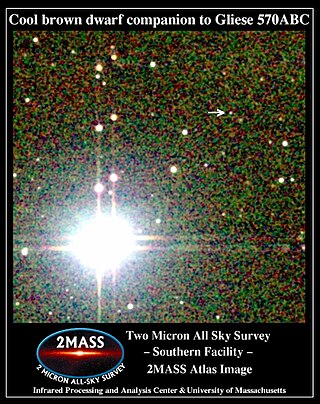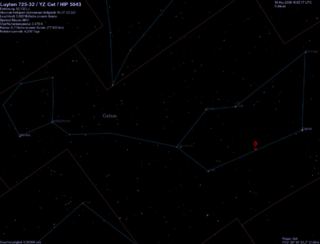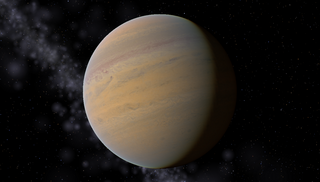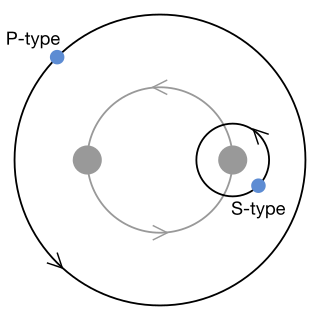
Libra is a constellation of the zodiac and is located in the Southern celestial hemisphere. Its name is Latin for weighing scales. Its old astronomical symbol is (♎︎). It is fairly faint, with no first magnitude stars, and lies between Virgo to the west and Scorpius to the east. Beta Librae, also known as Zubeneschamali, is the brightest star in the constellation. Three star systems are known to have planets.
Kapteyn's Star is a class M1 red subdwarf about 12.83 light-years from Earth in the southern constellation Pictor; it is the closest halo star to the Solar System. With an apparent magnitude of nearly 9 it is visible through binoculars or a telescope.

Alpha Librae is a double star and, despite its 'alpha' designation, it is the second-brightest star system in the constellation of Libra. The two components are designated α1 Librae and α2 Librae. The system bore the traditional name of Zubenelgenubi, though the International Astronomical Union now regards that name as only applying to α2 Librae.

Gliese 570 is a quaternary star system approximately 19 light-years away. The primary star is an orange dwarf star. The other secondary stars are themselves a binary system, two red dwarfs that orbit the primary star. A brown dwarf has been confirmed to be orbiting in the system. In 1998, an extrasolar planet was thought to orbit the primary star, but it was discounted in 2000.

YZ Ceti is a red dwarf star in the constellation Cetus. Although it is relatively close to the Sun at just 12 light years, this star cannot be seen with the naked eye. It is classified as a flare star that undergoes intermittent fluctuations in luminosity. YZ Ceti is about 13 percent the mass of the Sun and 17% of its radius.
Gliese 674(GJ 674) is a small red dwarf star with an exoplanetary companion in the southern constellation of Ara. It is too faint to be visible to the naked eye, having an apparent visual magnitude of 9.38 and an absolute magnitude of 11.09. The system is located at a distance of 14.8 light-years from the Sun based on parallax measurements, but is drifting closer with a radial velocity of −2.9 km/s. It is a candidate member of the 200 million year old Castor stream of co-moving stars.
Gliese 581 is a red dwarf star of spectral type M3V at the center of the Gliese 581 planetary system, about 20.5 light years away from Earth in the Libra constellation. Its estimated mass is about a third of that of the Sun, and it is the 101st closest known star system to the Sun. Gliese 581 is one of the oldest, least active M dwarfs known. Its low stellar activity improves the likelihood of its planets retaining significant atmospheres, and lessens the sterilizing impact of stellar flares.

Gamma Librae is a suspected binary star system in the constellation of Libra. It is visible to the naked eye, having an apparent visual magnitude of +3.91. Based upon an annual parallax shift of 19.99 mas as seen from Earth, it lies 163 light years from the Sun.
HD 4308 is a single star with an orbiting exoplanet in the southern constellation of Tucana. It has a yellow hue and is a challenge to view with the naked eye even under good seeing conditions, having an apparent visual magnitude of 6.54. This object is located at a distance of 72 light years, as determined from parallax measurements. It is a population II star and is considered to be a member of the thick disk. The star is receding from the Sun with a radial velocity of +95 km/s.
23 Librae is a star in the zodiac constellation Libra, making it visible from most of the Earth's surface. With an apparent visual magnitude of 6.45, it requires dark skies and good seeing conditions to see this star with the naked eye. It has a planetary system with two confirmed extrasolar planets.

23 Librae b, also known as HD 134987 b, is an extrasolar Jovian planet discovered in November 1999 orbiting the star 23 Librae. It orbits in its star's habitable zone.

47 Ursae Majoris b, formally named Taphao Thong, is a gas planet and an extrasolar planet approximately 46 light-years from Earth in the constellation of Ursa Major. The planet was discovered located in a long-period orbit around the star 47 Ursae Majoris in January 1996 and as of 2011 it is the innermost of three known planets in its planetary system. It has a mass at least 2.53 times that of Jupiter.

47 Ursae Majoris c, formally named Taphao Kaew is an extrasolar planet approximately 46 light-years from Earth in the constellation of Ursa Major. The planet was discovered located in a long-period around the star 47 Ursae Majoris. Its orbit lasts 6.55 years and the planet has a mass at least 0.540 times that of Jupiter.

Gliese 581c is an exoplanet orbiting within the Gliese 581 system. It is the second planet discovered in the system and the third in order from the star. With a mass at least 5.5 times that of the Earth, it is classified as a super-Earth.
Gliese 176 is a small star with an orbiting exoplanet in the constellation of Taurus. With an apparent visual magnitude of 9.95, it is too faint to be visible to the naked eye. It is located at a distance of 30.9 light years based on parallax measurements, and is drifting further away with a heliocentric radial velocity of 26.4 km/s.
HD 190984 b is an exoplanet which orbits the F-type main sequence star HD 190984, located approximately 486 light-years away in the constellation Pavo. This planet has a minimum mass three times that of Jupiter and takes 13 years and four-and-a-half months to orbit the star at a semimajor axis of 5.5 AU with an eccentricity of 0.57. This planet was detected by HARPS on October 19, 2009, together with 29 other planets.

An exoplanet is a planet located outside the Solar System. The first evidence of an exoplanet was noted as early as 1917, but was not recognized as such until 2016; no planet discovery has yet come from that evidence. What turned out to be the first detection of an exoplanet was published among a list of possible candidates in 1988, though not confirmed until 2003. The first confirmed detection came in 1992, with the discovery of terrestrial-mass planets orbiting the pulsar PSR B1257+12. The first confirmation of an exoplanet orbiting a main-sequence star was made in 1995, when a giant planet was found in a four-day orbit around the nearby star 51 Pegasi. Some exoplanets have been imaged directly by telescopes, but the vast majority have been detected through indirect methods, such as the transit method and the radial-velocity method. As of 1 June 2024, there are 5,742 confirmed exoplanets in 4,237 planetary systems, with 904 systems having more than one planet. This is a list of the most notable discoveries.
Gliese 146 is a star with an orbiting exoplanet in the constellation Horologium. Gliese 146 is also catalogued as HD 22496, HIP 16711, SAO-216392, and LHS 1563. With an apparent visual magnitude of 8.64, it is too faint to be visible to the naked eye. Gliese 146 is located at a distance of 44.4 light years based on parallax measurements, and is drifting further away with a heliocentric radial velocity of +21 km/s.

Iota1 Librae, Latinized from ι1 Librae, is a quadruple star system in the constellation Libra. Its apparent magnitude is 4.54. It is located 379 light years from earth.

Planets in binary star systems may be candidates for supporting extraterrestrial life. Habitability of binary star systems is determined by many factors from a variety of sources. Typical estimates often suggest that 50% or more of all star systems are binary systems. This may be partly due to sample bias, as massive and bright stars tend to be in binaries and these are most easily observed and catalogued; a more precise analysis has suggested that the more common fainter stars are usually singular, and that up to two thirds of all stellar systems are therefore solitary.









